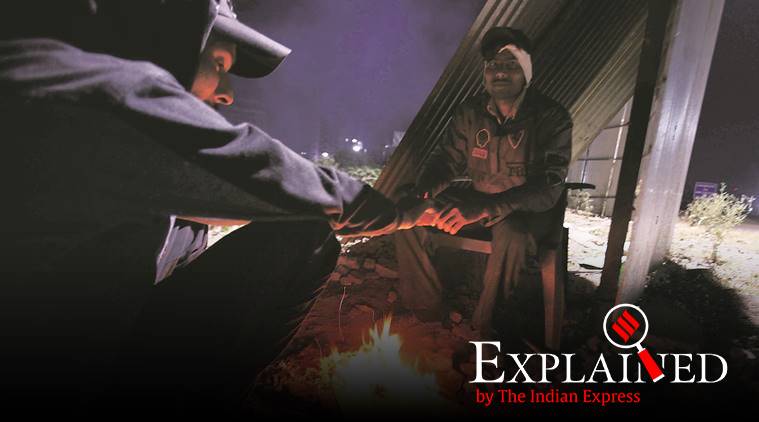 Pune saw its coldest day this season on January 17. (Express photo)
Pune saw its coldest day this season on January 17. (Express photo)
During the winter that went by, people barely needed woollens and the chill factor was conspicuously missing as Maharashtra experienced one of its warmest winter seasons in recent years. The Indian Express explains why the winter months were warmer than usual over parts of central and west India.
Compared to other years, how was this year’s winter season over Maharashtra?
Except for a handful of days in December and January, cold conditions were missing in parts of Maharashtra throughout the season. In fact, compared to last winter, the 2019-2020 season ended nearly a month in advance.
In India, winter lasts till the end of February, according to the season’s definition by the India Meteorological Department.
Chandrapur and Nagpur, where the mercury fell to 5 degrees Celsius on December 29 last year, recorded the lowest minimum temperatures in the state this season.
Pune, however, experienced its warmest December in 50 years. The minimum temperature recorded on Christmas day, here, was 19.5 degrees Celsius. It was the second warmest Christmas since 1970. The season’s coldest day in the city was January 17, when the minimum fell to 8.2 degrees Celsius.
Like Pune, Kolhapur, Solapur and Nashik also experienced the warmest winter in nearly two decades. This season was in complete contrast to winter 2018-19, which was far more severe in intensity and had lasted till mid-March last year. In the last season, some records in Maharashtra were reset when temperatures plummeted to 3 degrees Celsius in parts of Vidarbha.
Pune, too, had recorded a minimum temperature of 5.1 degrees Celsius last season.
Which factors bring cold conditions over the state?
Soon after the post-monsoon rain received in October, the temperature in Maharashtra begins to fall from the beginning of November. As the winter season progresses, cold conditions, caused due to the passing of western disturbances over the extreme northern parts of India, combined with associated cold northerly winds, begin to affect the region.
Western disturbances are eastward, propagating extratropical storms originating from the Mediterranean Sea. These fast-moving winds affect regions like Afghanistan, Pakistan and India in their course. They often result in snowfall, rain or affect temperatures over north India. The associated cold northerly winds then blow across central India and reach Maharashtra during the season. Here, winter peaks during December and similar chill is reported for a few days in January.
Usually, the state experiences at least one severe cold wave and an average of up to three cold wave events during a season. During an event of cold wave, areas over Vidarbha, Marathwada and north Madhya Maharashtra remain severely affected, causing minimum temperatures to drop below 10 degrees Celsius for a prolonged period.
Why did the state experience such a warm winter this season?
This season reported no cold spells and only just one mild event of cold wave. When minimum temperatures recorded over an area shows a departure of 5 – 6 degrees Celsius from normal (except in coastal areas), IMD declares a cold wave. On most days during the season gone by, the minimum temperatures hovered above normal, making the nights and early mornings warmer.
In contrast, Met officials noted cold day conditions, as maximum temperatures in many areas fell below normal and made days cooler. Cold day conditions were triggered due to foggy conditions, when the maximum temperature recorded was either 16 degrees Celsius or below.
According to IMD, this season saw the presence of prolonged anti-cyclone systems over central India regions. As a result, the cold northerly winds got blocked and failed to penetrate parts of Maharashtra. As each anti-cyclone system generally lasts for eight to 10 days, cold northerly winds, the main reason for cold conditions, remained absent.
Yet another strong link was the continuous inflow of moisture-laden sea winds, both from the Arabian Sea and Bay of Bengal. On multiple occasions, their confluence over Maharashtra resulted in overcast sky conditions and fog during morning hours. At times, they also triggered sporadic rainfall over Vidarbha, north Madhya Maharashtra and Marathwada in December and January.
However, these weather systems did not affect north India, as cold conditions prevailed across the northern plains, like Delhi, this season.
How did the temperatures affect agricultural output?
While losses to select rabi crop were reported, preliminary assessments indicate some losses caused to wheat, and significant damage to seasonal fruit and vegetable crops. As the day temperatures recorded over the state were below normal, the growing crops didn’t get the required amount of sunlight, particularly during the maturing stage.
Cold conditions favour production of strawberry and grape, which are among the major fruits that are grown and heavily exported from the state. But a likely worrying factor is the seasonal transition as there have been at least three instances of early heat wave conditions lingering over coastal Maharashtra, recorded in the last 10 days of February.